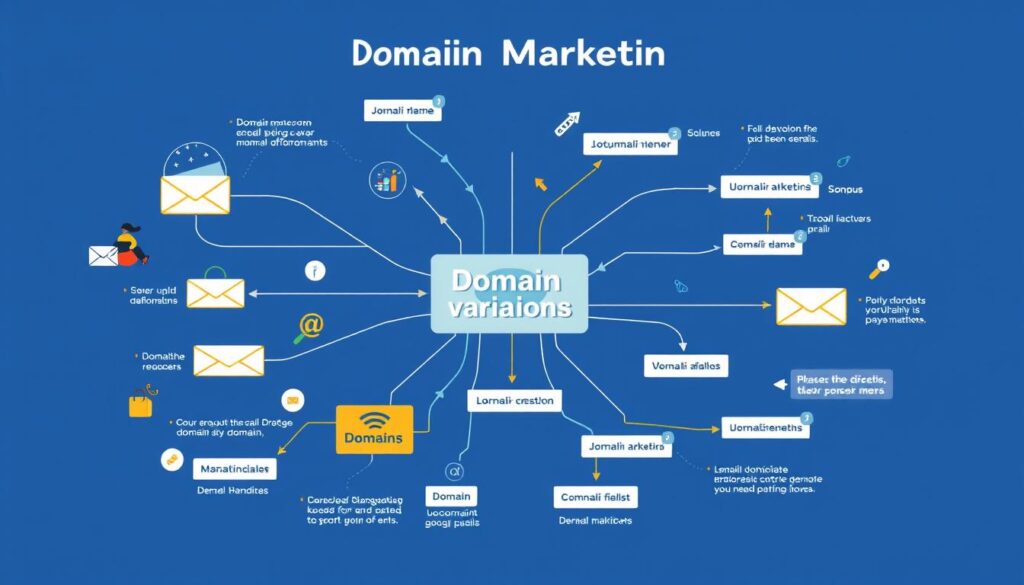Cold email campaigns need smart domain management to boost success. Choosing the right domain variations is key. Marketers must understand the complex world of email to overcome challenges.
Using different domains helps keep your emails out of spam filters. This way, your messages are more likely to reach their destination. It’s a smart move to improve your cold email campaigns.
For savvy marketers, email infrastructure is more than tech. It’s a strategic tool for connecting with clients. It helps keep your emails delivered right to their inbox.
Key Takeaways
- Domain variations protect email sender reputation
- Strategic domain management enhances email deliverability
- Multiple domains reduce risk of complete communication shutdown
- Proper domain rotation prevents potential spam detection
- Comprehensive domain strategy supports long-term outreach success
Understanding Domain Variations in Cold Email Marketing
Professional email prospecting needs a smart plan for managing domains. Companies aiming to build effective email lists must grasp the importance of domain variations in cold email campaigns. This strategy helps marketers tackle the digital communication world and boost their reach.
Email marketers struggle to keep high delivery rates. Domain rotation strategies are key to beating these challenges and getting messages to the right people.
Defining Domain Rotation Strategy
Domain rotation means using different email domains for cold email outreach. It helps avoid:
- IP address blacklisting
- Spam filter triggers
- Reputation damage
Impact on Email Deliverability
Building a strong email list depends on a good sender reputation. By using various domains for email campaigns, marketers can:
- Lower the chance of being seen as spam
- Boost inbox placement rates
- Keep the main domain’s reputation safe
Key Components of Domain Management
Effective email prospecting demands careful domain handling. Important parts include:
- Regular checks on domain health
- Authentication protocols (SPF, DKIM, DMARC)
- Steady email warming techniques
Smart domain variation turns cold email campaigns into precise marketing tools.
Why Domain Variations Matter for Cold Email Success
Targeted email marketing needs smart domain management to work well. Using different domains helps navigate the email world. It keeps the main domain safe while opening up more ways to talk to people.
Email deliverability is a big problem for marketers. Domain changes help solve this issue. By switching domains, companies can:
- Lower the chance of being completely blocked
- Spread out the email load on different domains
- Keep email engagement steady
- Keep the main business email safe
Using different domains helps email marketers grow their campaigns safely. They know that having various domains is key to avoiding email delivery problems.
Good email campaigns need smart domain handling. By using many domains, companies can get more emails into inboxes. This keeps their email plans working well.
Top email marketing teams know domain changes are key. They can manage many domains, making their marketing plans more flexible.
Essential Domain Variations for Cold Email Strategies
Creating a good cold email strategy means thinking about domain variations. Marketers need to build a smart approach to email lists. This approach should boost deliverability and get more people to engage.
Primary Domain Setup
Building a strong primary domain is key for email marketing success. Businesses should focus on a few important things:
- Choose a domain that shows your brand well
- Make sure your domain is credible with the right checks
- Keep your sender reputation clean
- Use SPF and DKIM to help emails get through
Subdomain Implementation
Subdomains are a smart way to handle email lists. They let you manage different types of emails without hurting your main domain. You can use subdomains for different campaigns or departments.
- Marketing campaigns
- Sales outreach
- Customer support communications
- Product announcements
Alternative TLD Considerations
Looking into different Top-Level Domains (TLDs) can boost your email marketing. Various TLDs can give your brand a unique look and might help emails get through better.
- .io for tech-focused campaigns
- .co for startup outreach
- .biz for business-oriented communications
- .net for network-related messaging
Picking the right domain variations needs careful thought. You must consider your marketing goals and who you’re trying to reach. Using these strategies well can make your cold email campaigns much more effective.
Setting Up Multiple Domains for Email Outreach
Creating a good domain strategy is key for b2b email success. Businesses must plan well to manage many domains for email outreach. This involves careful planning and smart setup to improve email delivery and interaction.
When setting up multiple domains, consider these important points:
- Select unique domain names that show your brand
- Register domains with trusted registrars
- Set up DNS for better email performance
- Use email authentication protocols
Choosing the right domains is crucial in b2b email strategies. Pick domains that match your main brand but are different to avoid spam filters. It’s wise to use your company name variations or create domains for specific purposes.
The technical setup has several key steps:
- Buy domains from reliable registrars
- Set up MX records for email delivery
- Implement SPF, DKIM, and DMARC for security
- Start email warmup processes
Managing domains well in b2b email strategies means always checking and improving. Keep an eye on domain reputation, track email performance, and be ready to change your strategy if needed.
Domain Variations for Cold Email: Best Implementation Methods
Using different domains in cold email campaigns needs a smart plan. Segmenting your email list is key to making the most of various domains. Good email marketers know that managing domains is more than just having many email addresses.
Getting good at email outreach takes careful planning and action. Companies must have a solid plan to make sure emails get delivered and people open them.
Domain Authentication Process
Getting your emails to land in the inbox is crucial. Marketers must follow important steps to prove their domains are legit:
- Set up SPF (Sender Policy Framework) records
- Configure DKIM (DomainKeys Identified Mail) signatures
- Implement DMARC (Domain-based Message Authentication) policies
Warming Up New Domains
Starting with new domains needs a slow and careful approach. Segmenting your email list helps in making a warm-up plan:
- Start with sending fewer emails
- Slowly send more emails over time
- Focus on groups that are more likely to engage
Monitoring Domain Health
Keeping an eye on your domains is important for their long-term success. You should watch these key numbers:
- Sender reputation scores
- Bounce rates
- Spam complaint percentages
- Engagement rates
By following these best practices, businesses can improve their cold email campaigns. They can also keep their domains in top shape.
Avoiding Common Domain Variation Pitfalls

Managing domain variations in email marketing is key. It needs careful planning and execution. Marketers face big challenges that can harm their campaigns if not handled right.
To succeed in email nurturing, managing domains well is crucial. Avoiding common mistakes is important. These include:
- Using one domain too much, which can lead to spam filters
- Ignoring domain authentication steps
- Not keeping branding consistent across domains
- Not checking domain reputation
Knowing these risks helps marketers create better email strategies. Here’s a look at major domain mistakes:
| Pitfall | Risk Level | Mitigation Strategy |
|---|---|---|
| Rapid Domain Exhaustion | High | Implement gradual domain rotation |
| Authentication Gaps | Critical | Complete SPF, DKIM, DMARC setup |
| Inconsistent Sender Profiles | Medium | Maintain uniform branding guidelines |
Keeping an eye on domains and managing them well is vital. It helps keep emails delivered and effective in nurturing prospects.
Domain Rotation Strategies for Large-Scale Campaigns
Running personalized cold emails on a big scale needs smart domain rotation plans. Top email marketers know how key it is to handle many domains. This keeps emails delivered and gets more people to open them.
Big email campaigns need a smart plan for managing domains. Using clever rotation methods helps keep a good sender reputation. It also makes cold emails more effective.
Schedule Planning for Domain Rotation
Good domain rotation starts with careful planning. Marketers should make a detailed plan for sending emails on different domains:
- Make a calendar with set times for each domain
- Spread out email sends to avoid sudden increases
- Use different domains for different groups of people
Volume Distribution Techniques
Smartly spreading out email volumes is key for keeping emails delivered. Cold emails should be evenly distributed across domains to dodge spam filters:
- Begin with fewer emails on new domains
- Slowly increase how many emails you send
- Keep sending patterns steady
Performance Tracking Strategies
It’s vital to watch how domains perform. Use strong tracking to see how well each domain does:
- Watch important metrics like open rates and click-through rates
- Use tools to compare how domains do
- Find and fix domains that don’t do well fast
With these domain rotation strategies, businesses can greatly boost their email outreach success.
Legal Compliance and Domain Management
Understanding the legal side of domain variations for cold email is key. Businesses need to know the laws that guide email use. This helps them stay in line and keep their email campaigns safe.
The CAN-SPAM Act sets rules for email marketing. Marketers must follow these rules when using domain variations for cold emails:
- Provide clear sender identification
- Include accurate header information
- Offer transparent unsubscribe mechanisms
- Honor opt-out requests within 10 business days
Managing domains is more than just tech stuff. It’s also about following the law. Companies need strong systems to track and manage their domains across different channels.
Important legal points for domain variations include:
- Maintaining consistent sender information
- Implementing comprehensive consent mechanisms
- Documenting communication permissions
- Ensuring transparency in email marketing practices
Staying ahead of legal issues helps businesses avoid fines and keeps customers trusting them. By managing domains well and knowing the law, companies can make their cold emails work better. This way, they can reach out effectively without breaking any rules.
Tools and Software for Domain Variation Management
Managing domain variations in cold email outreach campaigns needs advanced software. The right tools help manage domains better, improve email delivery, and boost campaign success.

Dealing with domain variations is complex. Modern cold email campaigns use strong software for managing domains well.
Automation Solutions
Good automation tools make domain variation strategies better. They help marketers:
- Automatically switch domains
- Manage many email accounts
- Set sending times
- Keep IP reputation safe
Analytics Platforms
Advanced analytics give deep insights into cold email campaigns. They offer:
- Tracking performance across domains
- Engagement metrics
- Conversion rate analysis
- Deliverability checks
Monitoring Tools
Good monitoring tools keep domain health in check. Top solutions include:
- Real-time domain reputation tracking
- Spam score checks
- Blacklist monitoring
- Alerts for issues
Choosing the right tools can greatly improve cold email campaigns. It ensures they work well and follow rules.
Measuring Success in Multi-Domain Campaigns
Measuring the success of targeted email marketing across many domains needs a smart plan. It’s important to look at key metrics to see how well emails work. This helps us understand what makes a campaign successful.
Important metrics for checking how well email campaigns do include:
- Deliverability rates
- Open rates
- Click-through rates
- Conversion rates
By looking at these metrics, marketers can make their email campaigns better. They want to see how each domain does and find ways to get better.
| Metric | Ideal Range | Optimization Strategy |
|---|---|---|
| Deliverability Rate | 95-99% | Domain authentication, list cleaning |
| Open Rate | 20-30% | Compelling subject lines, segmentation |
| Click-Through Rate | 2-5% | Personalized content, clear CTAs |
| Conversion Rate | 1-3% | Targeted messaging, landing page optimization |
Having a strong tracking system helps marketers keep improving their email marketing. By watching how domains perform and making changes, they can keep their campaigns successful.
Advanced Domain Warming Techniques
Mastering domain warming is key for a successful email list. It needs careful planning and execution. This helps build a strong reputation across different domains.
Building an email list requires a detailed approach to warming up domains. Marketers use advanced techniques to gain trust from email providers and subscribers.
- Start with low-volume sending (25-50 emails per day)
- Target highly engaged subscribers first
- Create interactive content that encourages recipient engagement
- Implement intelligent sending patterns
Advanced warming strategies aim to mimic natural email patterns. This means sending emails in a way that avoids spam filters and alerts from email providers.
| Warming Stage | Daily Email Volume | Engagement Strategy |
|---|---|---|
| Initial Phase | 25-50 emails | Highly targeted subscribers |
| Intermediate Phase | 100-250 emails | Segmented audience interaction |
| Advanced Phase | 500-1000 emails | Comprehensive engagement metrics |
Building a successful email list takes time and attention to detail. Marketers must watch domain performance, tweak sending patterns, and keep improving to keep delivery rates high.
- Monitor open rates
- Track engagement metrics
- Adjust sending frequency based on performance
- Maintain consistent domain reputation
Professional email marketers know domain warming is an ongoing effort. It’s about building trust and credibility with email providers and potential subscribers.
Future-Proofing Your Domain Strategy
Professional email prospecting is changing fast. It needs smart strategies to stay ahead. The digital world keeps changing, making it hard for marketers to keep up with new tech and trends.
To succeed in email prospecting, you need to plan ahead. Businesses must build strong plans that can handle new tech and changes in how we communicate.
Emerging Technologies
- AI-powered email authentication systems
- Machine learning filter optimization
- Blockchain-based verification mechanisms
- Advanced predictive deliverability algorithms
Adaptation Strategies
- Regular technology ecosystem assessment
- Continuous learning and skill development
- Flexible domain management protocols
- Investment in cutting-edge email infrastructure
Risk Mitigation
| Risk Category | Mitigation Strategy |
|---|---|
| Technological Obsolescence | Quarterly technology audits |
| Deliverability Challenges | Multi-domain rotation techniques |
| Security Vulnerabilities | Advanced authentication protocols |
By using smart, forward-thinking methods, companies can keep their email prospecting strong. This is key in today’s complex digital world.
Conclusion
Domain variations for cold email campaigns are key in today’s digital world. Email marketing keeps changing, needing smart ways to keep emails delivered and engaging. Just sending emails isn’t enough anymore.
To do well with domain variations, you need a solid plan, smart authentication, and ongoing checks. Using different domains in emails can lower the chance of damage to your reputation. It also makes your messages more effective. Businesses should learn about domain rotation and warming strategies well.
Email algorithms are getting more complex, so we must update our domain strategies. The goal is to build a strong sender reputation and trust with your audience. Good domain management sets successful marketers apart from those who can’t reach their audience.
Looking ahead, domain variations should be a big part of your email strategy. Keeping up with new tech, learning, and managing risks are vital. The future is for those who can manage their domains well and keep their messages engaging and professional.
